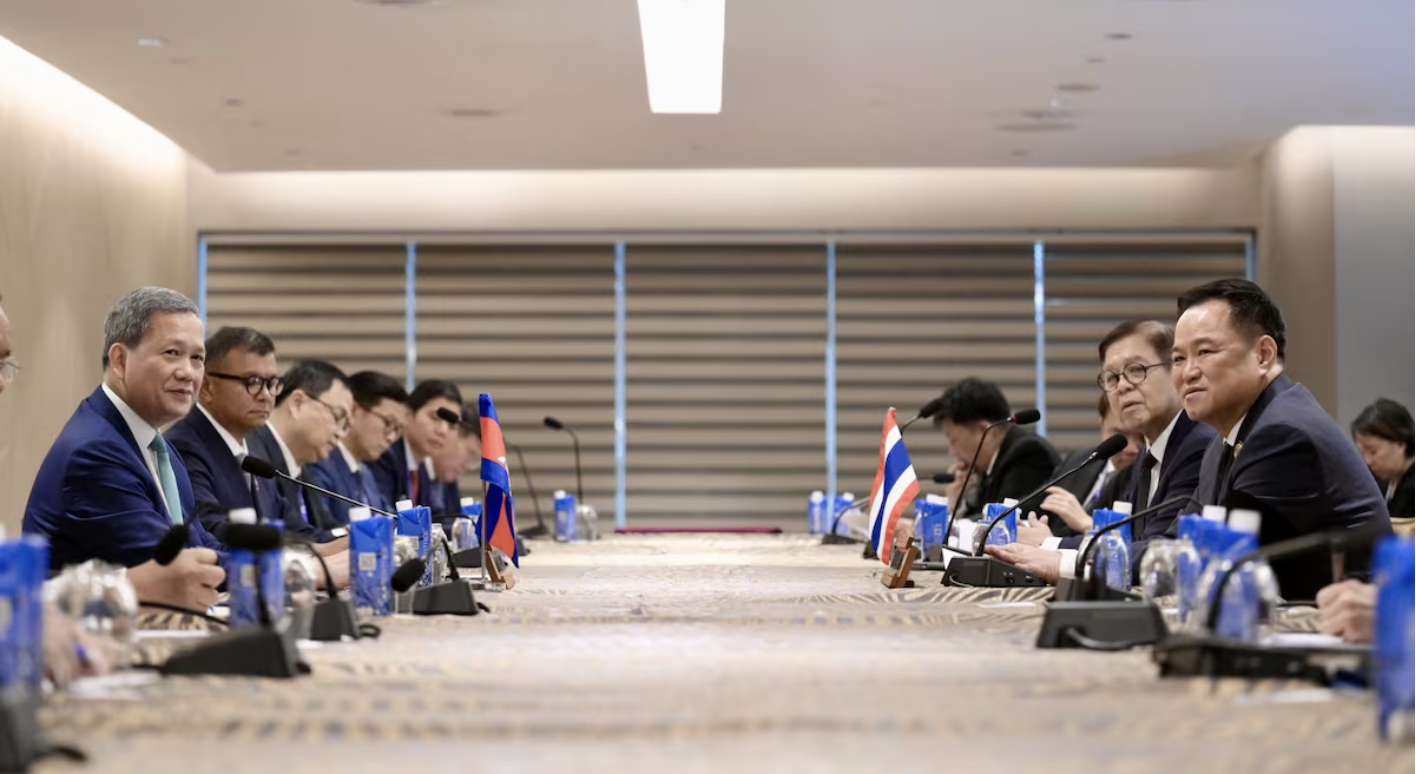“Peace at any Price?”—The Breakdown of the Thai-Cambodian Truce
Photo via Reuters
AIYANA KAUL: In late July 2025, the long-dormant border conflict between Thailand and Cambodia exploded into open warfare after a land-mine blast near the sacred Hindu temple of Ta Muen left Thai soldiers wounded. The ensuing artillery exchanges marked the gravest fighting between the neighbours in years.
From that flashpoint emerged a seemingly bold diplomatic revolution: on Oct. 26, under Donald Trump and Anwar Ibrahim’s watch at the 47th ASEAN Summit in Kuala Lumpur, Thailand and Cambodia signed the so-called “Kuala Lumpur Peace Accord.” Yet just two weeks later, Bangkok announced it was suspending implementation of the pact—not over diplomatic niceties, but after four were injured and one Thai soldier lost a foot stepping on a land-mine.
The border flare-up began when a mine explosion triggered Thai artillery retaliation—escalating into five days of fierce fighting and the displacement of hundreds of thousands. What made the situation different this time was the diplomatic leverage: the U.S. publicly warned that both countries risked tariffs of up to 36% on their exports unless they ceased hostilities. The ultimatum pushed Thailand and Cambodia into talks they had initially resisted, paving the way for the October accord.
However, the deal signed in Kuala Lumpur was, in many ways, a patch rather than a solution. It addressed immediate hostilities but left the core border dispute—centred on colonial-era maps and sacred sites like Ta Muen Thom—unresolved.
Moreover, Thailand’s acceptance was conditioned by its own domestic politics. The government in Bangkok, led by Anutin Charnvirakul since September, was under pressure to show a strong response to avoid being seen as capitulating in its long-standing rivalry with Cambodia.
The U.S. trade-leverage angle also introduced resentment. Thailand’s elites and public, aware of the country’s 1997 economic crisis and the role of external pressure since then, found the tariff ultimatum less a diplomatic overture than raw coercion.
In short: a peace deal achieved under duress rarely yields deep trust.
On Nov. 10, a Thai patrol stepped on a land mine in Sisaket province, leaving one soldier permanently injured. The Thai military blamed Cambodia for placing new mines in violation of the accord. Phnom Penh denied the charge, explaining the blast likely came from older, uncleared ordnance. Thailand responded by suspending implementation of the cease-fire pact: troop withdrawals, prisoner exchanges and de-mining efforts were all put on hold. In diplomatic parlance, the truce is “on pause,” but in practical terms it may be unraveling.
So, what does this mean for U.S. influence in Southeast Asia? The United States entered the crisis less as an ally and more as an outside power imposing its will, leveraging tariffs instead of trust. That approach succeeded in forcing the cease-fire, but it also deepened Thai resentment. The Thai government and military began looking beyond Washington’s classical alliance playbook. At the same time, Beijing’s quiet presence loomed large. China continues to deepen ties with both Thailand and Cambodia—military, economic, and infrastructure links. Bangkok’s growing embrace of Chinese investment and strategic cooperation means that the U.S.’s historic “anchor” in Thailand is increasingly under strain.
Should the Thailand-U.S. relationship falter further, Southeast Asian states may conclude: tough U.S. demands yield short-term results, but long-term influence is achieved differently.
As one looks ahead, there are several possible scenarios that may occur. Firstly, there may be a relapse into skirmishes: the mine-blast incident may simply be the first in a series of violations. Without robust monitoring, the border could spin back into hostilities.
Secondly, there could be a diplomatic freeze: Thailand may maintain the suspension, de-linking broader cooperation from the border truce—and signal to the U.S. that it will not tolerate external diktats.
Thirdly, there could be a reset via ASEAN/China: with U.S. leverage weakened in Bangkok, Thailand and Cambodia may turn to regional institutions or China to mediate—thus bypassing Washington's traditional role.
Finally, there could be a renewed U.S.-Thailand tug-of-war: the U.S. may redouble efforts, but unless it changes tactics from warnings and tariffs to genuine partnership diplomacy, Thai public opinion may tilt further toward Beijing.
The Thailand-Cambodia truce seemed the most high-profile diplomatic victory for the U.S. in Southeast Asia for years. But for all the spectacle at Kuala Lumpur, the ceasefire now appears to be in jeopardy. In Bangkok’s eyes, a deal obtained under trade threats lacks legitimacy; in Washington’s, the rollback of the truce signals waning influence.
The key takeaway for Indo-Pacific strategy is this: enforcing cooperation through pressure may work once. Sustaining alliances, however, requires trust, mutual interest, and legitimacy—not leveraged tariffs and ultimatums.
Aiyana Kaul is a staff writer for On The Record from London, U.K., and a freshman in the SFS studying IPOL.

